Awareness of Transfer Student Needs Assessment
To determine the current levels of awareness about the transfer student population and their significance to retention at Oklahoma State University (OSU) among key constituents, I created a presentation on transfer student success and retention administered through Qualtrics. This presentation highlighted the percentage of transfer students within OSU and their enrollment and retention trends. It included transfer student population characteristics, their academic and social needs, and research-based ways to support their retention.
The three categories outlined by Linda Suskie (2009) inform the learning goals for the transfer student success and retention presentation. In addition, praxis, as discussed by Freire (1970/2000) from the perspective of critical reflection and action, informs these goals. Key constituents for the purpose of this assessment included decision-makers at Oklahoma State University, namely, members serving on the Council of Directors of Student Academic Services (DSAS), the Inclusive Excellence Advisory Board (IEAB), and advisors from various colleges who engage with students.
- Knowledge or conceptual understanding: Key constituents will become aware of transfer student needs and enrollment trends at OSU as reported by the Office of Institutional Research Analytics.
- Attitudes, values, disposition, and habits of mind: Key constituents will recognize the significance of the transfer student population to OSU’s retention and the need to make transfer student success an institutional priority.
- Thinking and other skills: Key constituents will develop a sense of ownership and agency to review and change current policies and procedures within their units to better support the transfer student population
The intended learning outcomes from the presentation include the following:
- Key constituents will articulate transfer student needs and significance of transfer student enrollment trends to OSU’s retention efforts
- Key constituents will demonstrate willingness to collaborate with campus partners to support the institutional prioritization of the transfer student population
- Key constituents will apply the awareness about the transfer student population and their significance to retention gained from the transfer success and retention presentation to reflect and review current policies and procedures within their units to better support the transfer student population.
Based on these learning goals and outcomes for the presentation, I designed the initial survey completed by the key constituents prior to the presentation, and the subsequent survey completed after the presentation to assess the following:
- The purpose of the initial survey is to assess the current awareness about the transfer student population and their significance to retention among key constituents prior to the transfer success and retention presentation
- The purpose of the subsequent survey is to assess the shifts in awareness about the transfer student population and their significance to retention, if any, among key constituents after the transfer success and retention presentation
- Another purpose of the subsequent survey is to assess the perceived needs and barriers to supporting the transfer student population
Appendix A and B lists the initial and subsequent survey questions, respectively. A unique identifier of the respondents’ choice allowed me to maintain respondents’ anonymity and connect their responses across surveys. An analysis of the survey responses showed that among the DSAS members (n=14), a greater percentage of respondents answered the questions correctly after the presentation (see Figure 1).
Figure 1
Learning Outcomes for the Council of Directors of Student Academic Services
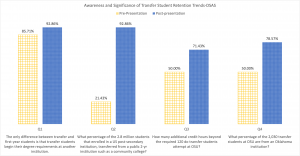
Among IEAB members (n=10), the percentage of respondents who answered the questions correctly remained the same for questions 1 and 4 but increased for questions 2 and 3 after the presentation (see Figure 2).
Figure 2
Learning Outcomes for the Inclusive Excellence Advisory Board

Among the advisors (n=6), the percentage of respondents who answered the questions correctly remained the same for questions 1 but increased for the other three questions after the presentation (see Figure 3).
Figure 3
Learning Outcomes for the Advisors
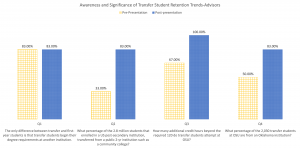
Across the presentations to the three constituent groups, the survey results demonstrate that there was an increase in the awareness and significance of transfer students to retention after the presentation.
An analysis of the responses on OSU’s ability to do more to support transfer student retention showed that all respondents across all key constituent groups answered yes. For the question focused on the respondents’ ability to reflect on the existence of campus partners with whom they could collaborate to better support transfer students, all respondents from DSAS and the advisors’ groups answered yes, while among the IEAB respondents, 90% answered yes and 10% answered no. The final question on the subsequent survey centered on the respondents’ ability to critically reflect on the needs and barriers to the transfer student population at OSU. The word clouds presented in Figures 4, 5, and 6 serve to visualize the most identified needs and barriers to transfer students by key constituents in DSAS, IEAB, and the advisors, respectively.
Figure 4
Needs and Barriers Identified by DSAS
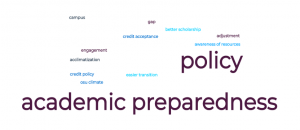
Figure 5
Needs and Barriers Identified by IEAB 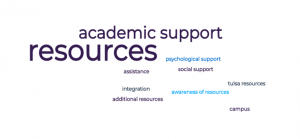
Figure 6
Needs and Barriers Identified by Advisors
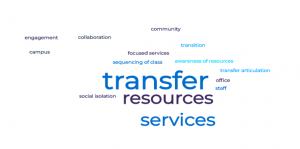
Based on these results, I can ascertain that among the key constituents at OSU who took the initial and subsequent surveys, there was an increase in the awareness about the transfer student population and their significance to retention efforts after the presentation. This type of theory-to-practice presentation accompanied by an assessment component not only supports learning among key constituents across the institution, but also serves to address underlying misconceptions about transfer students and foster the creation of a transfer-receptive culture.
Institutional change agents who wish to create such as transfer-receptive culture would require the support of key constituents and benefit from mobilizing other transfer champions or change agents to ensure sustained efforts in creating such a culture. Towards this goal, change agents can borrow lessons from grassroots organizing and changemaking approaches. Kezar (2018) recommends a multifaceted approach to understanding and enacting change that begins with the change agent analyzing the scope of change required. As outlined in an earlier section, some of the ways to support transfer student success and retention include the creation of centralized resources and a transfer-receptive culture within an institution. The creation of centralized resources may require less time and effort and would be relatively easier to accomplish compared to addressing core structural changes such as the institutional culture toward transfer students. The scope of these changes could therefore be classified as first-order and second-order change, respectively. The remainder of this paper will focus on changemaking literature, community organizing practices and the ways in which they can inform grassroots leaders’ strategies and approach to creating a transfer-receptive culture.

